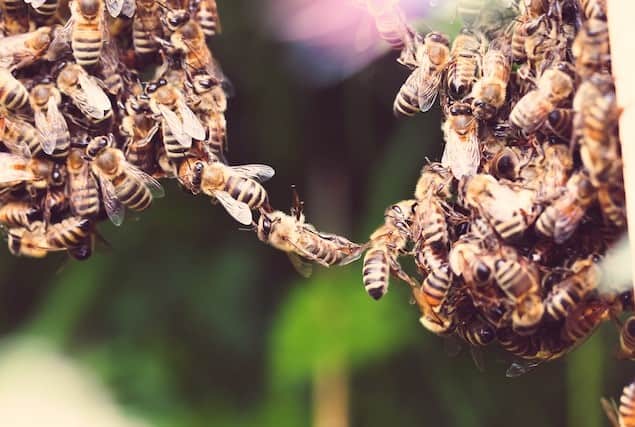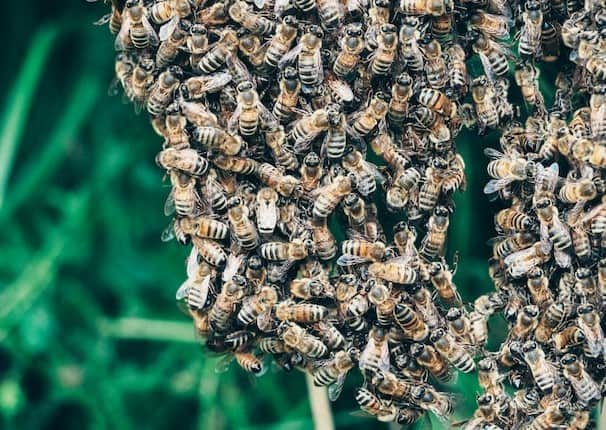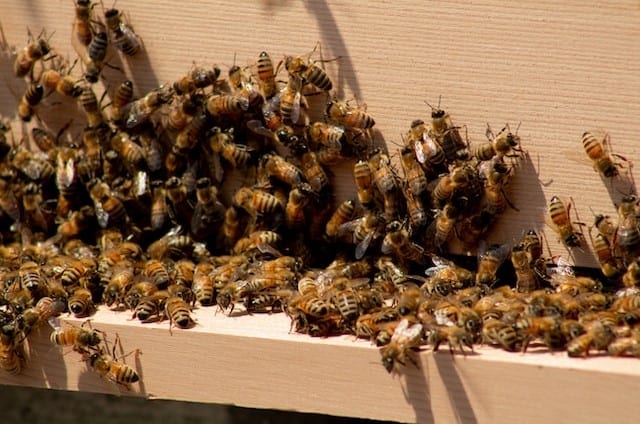We, beekeepers, take notice of the many intricate things our industrious friends do. We note every detail of the things they do to understand them better.
One of the things you might have noticed is your bees are linking their feet together, forming a chain-like link. This behavior is called bee festooning.
This is just one of the behaviors that bees engage in that we need more of an understanding of.
While there is beauty in festooning bees, the honey bees actually festoon not to add aesthetics to the hive. Rather, they do so for a specific purpose.

What is Bee Festooning?
Festooning is the act of bees joining their feet together (looking like they are holding hands). Festooning bees would hang together between frames, interlocking their legs.
When they festoon, bees hang together, forming a moving and living chain. This would closely resemble a single ‘chain’ of bees.
Here’s a short video of how bee festooning may also look like:
Why Do Bees Festoon?
There is no clear idea or purpose of bees festooning. The real reason behind the behavior is completely unknown.
However, many beekeepers have observed honeybees festoon as part of their comb-building activities, for temperature regulation, in preparation for swarming, and for communicating with other bees.
Regulates Wax Comb Secretion and Construction
Festooning is essential for comb construction and stability. One of its main benefits is to keep a constant temperature within the hive, which helps regulate wax secretion and wax production.
Bees produce beeswax better when temperatures reach 91°F or higher. It is also easier to manipulate for comb construction at such temperatures. Hence, when bees festoon, they are able to maintain the temperatures inside the hive, which is ideal for wax production and comb construction.
As worker bees notice some open space or gap inside the hive, they realize that they need to have these combs repaired. Honey bees would festoon to help with comb construction when old combs need repair or there is a need to build new combs.
During their comb-building activities, festooning bees act as a support for other bees. They form a chain-like structure that acts as scaffolding to support other bees. Wax combs that need repair are being worked on with the help of a living scaffold that bees create when they festoon.
At the same time, when bees festoon, they are able to judge the distance between two frames better.

Temperature Regulation Within the Hive
Many beekeepers also noticed that festooning bees are common when there are broods and larvae inside the hive. This leads to the assumption that bees festoon as a way to increase the temperature within the hive. The honey bees would festoon to keep their offspring warm and comfortable.
Also, bees would festoon to ventilate the hive. It is believed that festooning helps regulate the temperature inside the hive so that offspring and honey bees would not suffer from rising temperatures.
Swarming Preparation
Some beekeepers have noticed that before they swarm, bees would exit the hive and festoon. However, there is no clear explanation for this.
As speculation goes, it is suggested that bees are very social and uniform and would festoon in order to take part in a form of interaction.
Festooning in this context happens outside the hive. Honeybees would exit the hive and festoon. This act is considered a way for bees to interact before leaving to look for a new hive.
Better Communication
Finally, there are also beekeepers who believe that festooning occurs as a result of bees communicating with each other.
Bees are known to communicate through their waggle dance. During the waggle dance, bees communicate the location of food sources to other bees.
Another way that bees communicate is through their pheromones. Pheromones are chemicals released by the body to convey information to other bees.
Honey bees have many pheromones meant for specific purposes (see list here). During a predator attack, the bees would give off an alarm pheromone that would alert other bees of the danger from predators.
Many believe that the waggle dance and pheromones are not the only means of communication among honey bees. Festooning is added to this list.

Festooning and Colony Health
When you see honey bees hanging in long chains between frames inside the hives, there is no need to worry.
Festooning bees should not be a cause of concern. To assuage your worries, feel free to reach out to your local beekeeping community for the behavior of your honeybees.
Rather, it is a sign that the honey bee colony is healthy. When bees festoon, it shows that there are enough bees to support the hive. It can be an indication that the hive is healthy.
Take note, however, that festooning was mostly recorded during warm weather (supporting the assumption that it helps regulate the heat temperature within the hive).
During the winter, bees need to do more to keep the hive warm. They have to form clusters. Festooning would not be enough to generate heat for the honey bee colony’s survival.

Final Thoughts on Festooning Bees
Bee festooning is still a mystery for beekeepers or even scientists. Information on why bee festooning happens remains an enigma, so we are only left with various theories on how bees do their own business.
Comb-building, temperature regulation, preparing to swarm, or as a form of communication may be speculations. Nevertheless, they are logical explanations for why honeybees festoon.
With the many behaviors that bees are capable of doing, one thing is definite. Bees are smart and social organisms that are capable of working with one another in order to achieve a common goal.
No matter what the reason why bees festoon, this behavior surely helps them achieve their goals of building a thriving honey bee colony. It’s time we do our part in saving them.
Let’s plant more flowers to provide them with the pollen and nectar that they need to survive. Growing more trees would also provide them with a natural shelter. In our small ways, we can help save the bees!

